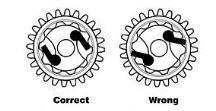Servicing Winches
Winches are required to carry deceptively high loads in harsh environmental conditions.
For proper operation, winches should be serviced regularly with attention to correct
assembly and inspection of save condition of all the parts.
All serious manufacturers will provide detailed service instructions for their winches.
These directions should be accurately followed to guarantee save operation and long lifetime.
Two to three times during the active sailing seasons, winches should be stripped, cleaned,
thoroughly checked and re-lubricated.
Especially at the beginning of the season, a complete service and inspection should be performed.
External Cleaning
The drum of the winches should be cleaned regularly with fresh water to prevent slushy
salt deposits on the drum surface.
Servicing
Service should be conducted according to the service manual supplied by the manufacturer.
In principle the service will include the following steps and precautions:
All components will be removed, checked and cleaned Before using cleaning agents such as paraffin, or white spirit,
the manufacturer directions should be checked. Only recommended greasing products must be used. The pawls (in the ratchet mechanics) should not be greased as this
can lead to pawls sticking in their pockets and disabling the winch.
Instead, light engine oil should be applicated for the pawls. Only small amounts of winch grease must be used when lubricating
ratchet tracks, gear teeth and bearings. Otherwise, excess grease will be forced out and may
deposit in potentially dangerous areas, such as pawl pockets.
|
Winches must be re-assembled in the reversed sequence to the order of dismantling.
When assembling ratchet gears, check the pawl engagement.
Incorrect assembly (pawl flipping as shown on the right) will lead to back winding
of the winch.
This is extremely dangerous so extreme care should be taken.
After re-assembly, the correct winch function should be checked immediately.
|

|
Draining
Winches are self-draining and care should be taken to ensure the
drain holes are not obstructed.
|
